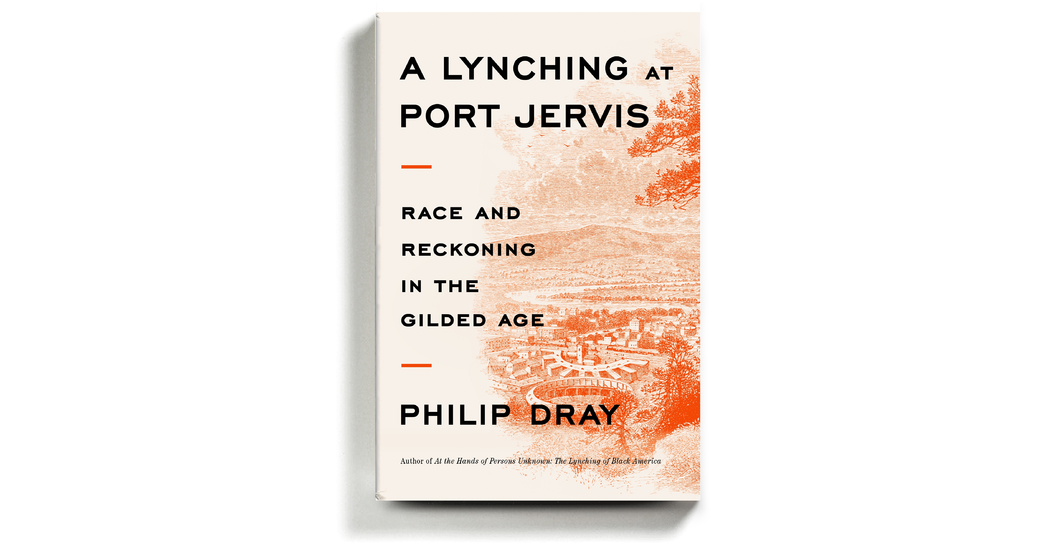
A LYNCHING AT PORT JERVIS
Race and Reckoning in the Gilded Age
By Philip Dray
Illustrated. 260 pages. Farrar, Straus & Giroux. $29.
On June 2, 1892, a white mob seized a Black man and hanged him from the high branch of an old maple tree in Port Jervis, N.Y. Several days later, a jury took all of an hour to deliver its verdict on what had happened: “Robert Lewis came to his death in the village of Port Jervis on June 2nd by being hanged by his neck by a person or persons unknown.”
The language for the verdict was passive and ungainly — a sentence that has to tie itself into knots in order to bear such moral contortions. Lewis was the victim of a lynch mob that attacked him after hearing rumors that he had sexually assaulted a white woman. The lynching had been witnessed by 2,000 people, yet nobody was held responsible for Lewis’s murder. By killing a man and not being punished for it, the mob had thereby achieved two goals — absolute power and absolute impunity. As Philip Dray puts it in his new book, “A Lynching at Port Jervis,” “The mob had not only ‘convicted’ and summarily executed Robert Lewis; it had now literally acquitted itself.”
Dray is also the author of “At the Hands of Persons Unknown” (2002), a comprehensive history of lynching in the United States. The title for that earlier book suggested how typical it was for lynch mobs to cultivate a pointed anonymity. In addition to serving the practical purpose of protecting lynchers from arrest and prosecution, the sense of collective irresponsibility had a symbolic function, too. “The lynching was seen as a conservative act, a defense of the status quo,” Dray wrote in “At the Hands.” “No persons had committed a crime, because the lynching had been an expression of the community’s will.”
What distinguished the Port Jervis lynching was where it happened. Of the 1,134 recorded lynchings of Black people in the United States between 1882 and 1899, it was the only one to take place in New York State. Port Jervis was a thriving town just 65 miles from Manhattan — a rail and manufacturing hub that prided itself on being the first municipality in the area to install electric street lamps. Dray describes how the crowd that attacked Lewis had paused beneath those street lamps — “the very symbol of Port Jervis’s most progressive aspirations” — sizing them up to decide whether they were sturdy enough for a hanging. Northerners who wanted to see lynching as a Southern problem couldn’t comfort themselves with their own pretensions to enlightenment. A newspaper headline the next day stated simply: SOUTHERN METHODS OUTDONE.
“A Lynching at Port Jervis” happens to arrive just over a week after a white supremacist murdered 10 Black people at a grocery store in Buffalo. Dray himself says that while his earlier books on civil rights history were guided by a confidence in racial progress, this time he doesn’t feel so sure. In addition to diminished voting rights and persistent police brutality, he cites the resurgence of armed vigilantism as an eruption of some very old forces “that refuse to die.” Dray deems the insurrectionists at the Capitol on Jan. 6 prime examples of what Abraham Lincoln called the “mobocratic spirit,” a lawless disorder that speaks the language of law and order. Lincoln said that this combination of arrogance and violence was what made vigilantism both spectacularly destructive and insidiously corrosive.
In the first part of his book, Dray guides us through the convoluted circumstances that led to Lewis’s murder, which involved a young white woman named Lena McMahon and her white suitor, Philip Foley. When seized by the mob, Lewis allegedly confessed to assaulting her, saying that Foley put him up to it; at another point Lewis denied any involvement altogether. McMahon, for her part, said she had been attacked by a Black man. Foley said he wasn’t there and so didn’t see what had happened. McMahon’s parents despised Foley and accused him of blackmailing the family by threatening to release some incriminating (and unspecified) information about their daughter. When Lena’s father entered the courtroom, he lunged at Foley and yelled, “He is the Negro that ought to have been hung.”
Dray is an excellent and conscientious storyteller, taking care to alert us when the historical record is spotty or ambiguous while still offering vivid specifics wherever he can. We learn that the railway in Port Jervis brought pride but also danger, with one elderly woman in town making a professional specialty of plucking out the hot cinders that flew from the locomotives into children’s eyes. Dray conveys how the cacophony of the crowd that killed Lewis was compounded by a participant who spoke through a tube in his throat: “His croaking, mechanically altered utterances added greatly to the sense of disorder.”
Even though some white Port Jervians expressed shock that a lynching had occurred in a quaint little burg like theirs, the writer Stephen Crane didn’t seem so surprised. Having left the Port Jervis of his childhood for the Jersey Shore, Crane heard that his older brother William had tried to stop the mob from murdering Lewis. Five years later, Crane wrote “The Monster,” a novella about a Black man who becomes disfigured saving a white child from a fire, and about the small town where they live, which was itself long disfigured by bigotry and intolerance.
By the summer of 1892, the African American journalist Ida B. Wells had recently relocated to New York City from Memphis, where her newspaper’s office was destroyed by a mob that was outraged by her reports about lynch mobs.She speculated that Lena McMahon may have been having a consensual affair with Robert Lewis — hence, Wells argued, the murky insinuations in Foley’s blackmail letters. Dray is agnostic on this question, an answer to which wouldn’t change the fact that a crowd kidnapped a man and hanged him from a tree: Absolutely nothing could justify the mob’s behavior.
That lynching was both a criminal act and a moral atrocity should have made the need for federal anti-lynching legislation obvious to anyone who cared about the rule of law. But one larger story that emerges from “A Lynching at Port Jervis” is how, for all the work of Wells and other anti-lynching activists, it took decades to achieve any legal inroads on “one of the very few issues impacting Black lives outrageous enough to arouse white concern,” as Dray writes.
Even then, his epilogue ends in medias res — with a man who was raised in Port Jervis remembering how the white boys would bully Black boys like him. Dray seems to sense that the story he has written remains unfinished; what happened in Buffalo earlier this month suggests that a terrible legacy from more than a century before lingers still.




